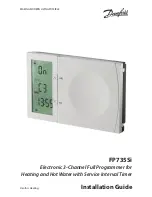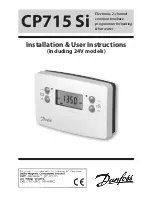
Page 2
Digital - Key - On / Off -button
Pressing the Digital key will activate the current channel selected (ch -7 and 8) output relay as ON or OFF.
This is a momentary switch. Press and hold the Digital key, when you want the relay to be ON, release OFF.
Relay - N.C, C, N.O connections.
N.C = Normally Closed position of the relay contacts ( Circuit is ON- will open circuit (OFF) when activated )
C = Common connection to relay contacts.
N.O = Normally Open position of the relay contacts ( Circuit is OFF- will close circuit (ON) when activated )
Relay / Pin Output Jumpers. When this jumper is in place, the board will control the on-board relays. The
relays are rated at 30 V @ 2 Amp. When the jumper is removed, the relay is de-activated and the output pins
may be used as voltage drivers ( 0 Vdc or 4.9 Vdc @ 100mA when on). The pins are marked with Plus (+)
and Minus (-) for correct polarity connection. Use caution when connecting to the pins to observe correct
polarity (+ / - )
Play - key
Replays a set of recorded relay actions.
During play back the channel LED’s will form a bar-graph indicating the amount of time used.
When the recorded routine has finished playing the bar-graph-LED’s will go out.
A switch, sensor may be connected to the REM connection and this will function in the same way as the
Play-key.
Next - channel key (servo ch 1-6, Relay ch 7-8, sound IC chip)
Changes the current active channel to the next channel.
Each key-press selects the next channel - servos 1 and 2, digital 3 and 4 and the sound chip.
Record - key (Servos, Relays and Sound IC)
The record - key has no effect unless enabled by the record-enable E/D Jumper. (see drawings for details)
Press and release the record key to start recording a routine. Press and release the Record-key to stop
recording. If the Record-key is held down when power is applied to the board, all memory will be erased.
(Takes approximately 20 seconds, LED will form a bar-graph indicating EEprom erasing is occurring.).
During the recording of a channel the LED’s will form a bar-graph indicating the amount of time being used.
When the action has finished playing the bar-graph-LED’s will turn off.
RECORD NOTE:
The recording on channel -1 will set the maximum available recording time for all other channels.
Always record channel -1 first, then the other channels ( 2-4 ). Recording periods for channels 2-4 cannot
be longer than for channel -1.
Record D / E Jumper - EEprom Protect.
The Record / Enable jumper protects the programmed routine in the EEprom. If the jumper is set at the "E"
enable position then recording will be permitted. Move the jumper to "D" disable recording to prevent
recording to the EEprom. The Record button E/D jumper will enable or disable button from operating.
SYNC Terminal - Output
Synchronizing connection for multiple board to be linked together. On-board terminal connection delivers a
pulse signal (50 msec) at the start of playback and record event which may be used to trigger other Wizard
boards connected in a chain or master module - slave module setup. SYNC output to REM input of other
boards.
REMote Terminal
Used to trigger Wizard board by remote switch, sensor. Can also be wired together for no-stop playback.
REM Jumper - H and L positions. ( Sensor N.O. or N.C. relay input option)
To begin playback when the input line drops from + to ground, set the REM jumper to the L position. To
begin playback when the action input goes from ground to + (sync pulse) set to the H position
LOOP - slide switch.
To make the Wizard - 11 board play the recorded moves repeatedly, move the switch to the "Y" position. The
recorded moves will start to play when the PLAY-key is first pressed. There will be a pause at the end of
playing (determine by the position of the Loop Delay control) after which the recorded action will start again.
Note: To record new program routines, the LOOP switch must be set to the "N" position.



































